The lens analyzer market is expected to grow from USD 167.4 million in 2025 to USD 260.0 million by 2035, supported by expanding clinical eye care capacity and rising demand for standardized optical measurement workflows. One key opportunity lies in the digitization of optical retail operations, where optical chains and independent opticians are transitioning from manual lens verification to automated analyzers that support faster throughput and reduced operator variability. Automatic and semi-automatic systems capable of measuring progressive, high-index, and coated lenses can significantly improve dispensing accuracy and customer satisfaction. As consumer expectations shift toward faster delivery of prescription eyewear, lens analyzers integrated with store-level digital fitting platforms and cloud-based prescription management will gain a competitive edge. Manufacturers that offer compact, user-friendly systems suited for smaller optical clinics and mobile eye-care camps can also expand penetration in emerging and semi-urban markets.
Another substantial opportunity is emerging in hospital ophthalmology departments and refractive surgery centers, where pre- and post-operative assessment of corrective lenses requires higher precision and consistency. Integration of analyzers with electronic medical record (EMR) systems, tele-ophthalmology platforms, and automated diagnostic suites will enable seamless patient data management and multi-device interoperability. Additionally, training initiatives and partnerships with optical schools, eye-care NGOs, and government vision screening programs can accelerate adoption in regions focused on reducing preventable vision impairment.

The subsequent period from 2030 to 2035 extends growth from USD 208.6 million to USD 260.0 million, adding USD 51.4 million or 55% of the decade's total expansion. This phase centers on widespread market penetration of automated measurement systems, enhanced integration with optical practice management platforms, and expanded compatibility with diverse vision care service standards. Market development signals fundamental shifts in how practitioners approach lens measurement optimization and diagnostic precision management, with industry participants positioned to capture demand across multiple operation mode categories and application segments.
The lens analyzer market exhibits distinct growth phases, each with distinct market characteristics and competitive dynamics. Between 2025 and 2030, the market advances through its technology adoption phase, expanding from USD 167.4 million to USD 208.6 million, with steady annual growth averaging 4.5%. This period showcases the transition from basic manual measurement systems to advanced automatic analyzer configurations with enhanced diagnostic capabilities and integrated data management systems becoming mainstream features.
The 2025-2030 phase contributes USD 41.2 million to market value, representing 45% of the decade's total expansion. Market maturation factors include standardization of optical measurement protocols, declining equipment costs for automated analyzer systems, and increasing practitioner awareness of diagnostic efficiency benefits reaching diverse hospital and optical shop applications. Competitive landscape evolution during this period features established ophthalmic equipment manufacturers like Topcon Corporation and Luneau Technology expanding their analyzer portfolios while specialty manufacturers focus on advanced measurement development and enhanced diagnostic capabilities.
From 2030 to 2035, market dynamics shift toward comprehensive automation integration and global optical practice expansion, with growth continuing from USD 208.6 million to USD 260.0 million, adding USD 51.4 million or 55% of total expansion. This phase transition centers on automated measurement systems, integration with practice management networks, and deployment across diverse hospital and optical shop scenarios, making these applications standard rather than specialized. The competitive environment matures with focus shifting from basic measurement capability to comprehensive diagnostic optimization systems and integration with patient care monitoring platforms.
| Metric | Value |
|---|---|
| Market Value (2025) | USD 167.4 million |
| Market Forecast (2035) | USD 260.0 million |
| Growth Rate | 4.5% CAGR |
| Leading Technology | Automatic Type Operation Mode |
| Primary Application | Hospital Segment |
The market demonstrates strong fundamentals with automatic type systems capturing a dominant share through advanced measurement precision and operational efficiency capabilities. Hospital applications drive primary demand, supported by increasing diagnostic service volumes and optical measurement technology requirements. Geographic expansion remains concentrated in developed markets with established eye care infrastructure, while emerging economies show accelerating adoption rates driven by healthcare expansion and rising vision care standards.
Market expansion rests on three fundamental shifts driving adoption across hospital, optical shop, and vision care sectors. First, diagnostic efficiency demand creates compelling operational advantages through lens analyzers that provide immediate measurement accuracy and prescription verification without compromising patient service quality, enabling practitioners to meet stringent diagnostic standards while maintaining clinical productivity and reducing measurement errors. Second, optical practice modernization accelerates as eye care providers worldwide seek advanced measurement systems that complement traditional examination processes, enabling precise lens parameter detection and quality verification that align with industry standards and patient care protocols.
Third, vision care enhancement drives adoption from hospitals and optical retailers requiring effective measurement solutions that maximize diagnostic accuracy while maintaining operational productivity during patient examination and lens dispensing operations. Growth faces headwinds from equipment cost challenges that vary across analyzer suppliers regarding advanced measurement technologies and automation features, which may limit adoption in cost-sensitive practice environments. Technical limitations persist regarding measurement range constraints and lens type compatibility that may reduce effectiveness in specialized prescription or complex lens scenarios, affecting diagnostic capability and service requirements.
The lens analyzer market represents a specialized yet critical diagnostic opportunity driven by expanding global eye care services, optical practice modernization, and demand for superior measurement accuracy in diverse vision care applications. As practitioners worldwide seek to achieve precise diagnostic effectiveness, reduce measurement errors, and integrate advanced analyzer systems with practice platforms, lens analyzers evolve from basic measurement devices to sophisticated diagnostic solutions ensuring service quality and operational leadership.
The market's growth trajectory from USD 167.4 million in 2025 to USD 260.0 million by 2035 at a 4.5% CAGR reflects fundamental shifts in eye care service requirements and optical measurement optimization. Geographic expansion opportunities remain particularly pronounced in Asia Pacific markets, while the dominance of automatic type systems and hospital applications provides clear strategic focus areas.
Strengthening the dominant automatic type segment through enhanced measurement algorithms, superior diagnostic accuracy, and integrated practice management systems. This pathway focuses on optimizing measurement precision, improving operational efficiency, extending diagnostic effectiveness across diverse lens types, and developing specialized configurations for varied applications. Market leadership consolidation through advanced technology engineering and automated workflow integration enables premium positioning while defending competitive advantages. Expected revenue pool: USD 28-38 million
Rapid eye care service and optical retail growth across Asia Pacific creates substantial expansion opportunities through local distribution capabilities and technology partnerships. Growing vision care demand and healthcare infrastructure development drive persistent demand for advanced analyzer systems. Localization strategies reduce import costs, enable faster service support, and position companies advantageously for hospital procurement programs. Expected revenue pool: USD 24-33 million
Expansion within the dominant hospital segment through specialized analyzer designs addressing clinical standards and diagnostic requirements. This pathway encompasses electronic health record integration, quality assurance coordination, and compatibility with diverse ophthalmology workflows. Premium positioning reflects superior diagnostic capability and comprehensive clinical compliance. Expected revenue pool: USD 22-30 million
Strategic expansion into optical shop applications requires enhanced user-friendly capabilities and retail-focused features addressing optical retail operational requirements. This pathway addresses rapid measurement processing, customer service enhancement, and point-of-sale integration with advanced technology for demanding retail environments. Premium pricing reflects specialized retail requirements. Expected revenue pool: USD 18-25 million
Development of advanced manually operated analyzer systems addressing budget-conscious practices and emerging market requirements. This pathway encompasses simplified operation, cost-effective alternatives, and reliable measurement capabilities for price-sensitive segments. Technology differentiation through efficient design enables diversified revenue streams while reducing dependency on premium automation platforms. Expected revenue pool: USD 15-21 million
Expansion through digital connectivity features including cloud-based data management, mobile application integration, and telemedicine compatibility. This pathway encompasses remote measurement access, patient data synchronization, and comprehensive practice analytics. Market development through connected technology enables differentiated positioning while accessing digitally-focused practices requiring integrated diagnostic solutions. Expected revenue pool: USD 13-18 million
Development of superior measurement technologies addressing advanced lens designs and specialized prescription requirements. This pathway encompasses progressive lens analysis, digital lens verification, and complex prescription measurement capabilities. Premium positioning reflects technological leadership and measurement expertise while enabling access to specialized optical practices requiring highest-precision measurement solutions. Expected revenue pool: USD 11-15 million
Primary Classification: The market segments by operation mode into Manually Operated Type and Automatic Type categories, representing evolution from basic measurement devices to automated diagnostic solutions for comprehensive optical practice optimization.
Secondary Classification: Application segmentation divides the market into Hospital and Optical Shop sectors, reflecting distinct requirements for diagnostic precision, measurement capacity, and operational workflow standards.
Regional Classification: Geographic distribution covers Asia Pacific, Europe, North America, and other regions, with developed markets leading adoption while emerging economies show accelerating growth patterns driven by healthcare expansion programs.
The segmentation structure reveals progression from manual measurement systems toward automated analyzer platforms with enhanced diagnostic and connectivity capabilities, while application diversity spans from hospital clinical settings to optical retail environments requiring precise measurement solutions.
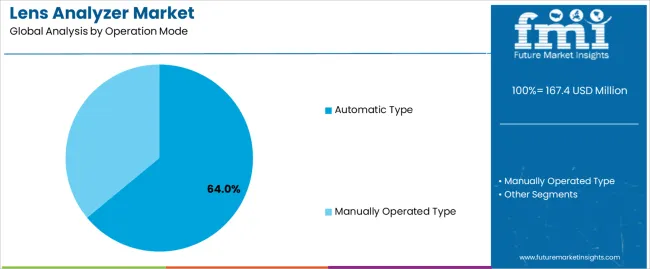
Market Position: Automatic type systems command the leading position in the lens analyzer market with approximately 64.0% market share through advanced measurement properties, including superior diagnostic speed, operational consistency, and automation capability that enable practitioners to achieve optimal measurement accuracy across diverse hospital and optical shop environments.
Value Drivers: The segment benefits from practitioner preference for efficient measurement systems that provide consistent diagnostic performance, reduced operator dependency, and workflow optimization without requiring extensive technical training. Advanced automation features enable rapid measurement cycles, data management integration, and compatibility with existing practice equipment, where analyzer performance and operational efficiency represent critical service requirements.
Competitive Advantages: Automatic type systems differentiate through proven measurement reliability, consistent diagnostic characteristics, and integration with practice management platforms that enhance operational effectiveness while maintaining optimal accuracy suitable for diverse vision care applications.
Key market characteristics:
Manually operated systems maintain cost-effective positioning in the lens analyzer market due to their economical equipment properties and basic measurement advantages. These systems appeal to practitioners requiring standard measurement capabilities with adequate performance for routine optical verification applications. Market adoption is driven by small optical shop expansion and budget-conscious practices, emphasizing reliable measurement solutions and operational simplicity through basic analyzer systems while maintaining competitive pricing structures.
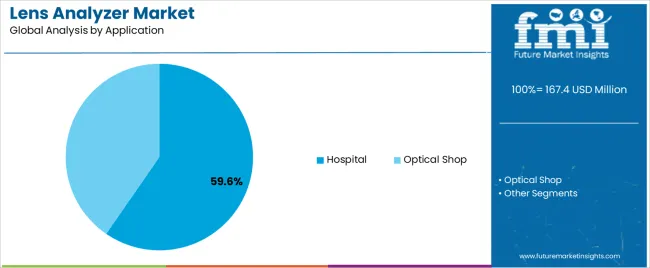
Market Context: Hospital applications dominate the lens analyzer market with approximately 59.6% market share due to widespread adoption of diagnostic measurement equipment and increasing focus on patient care quality, prescription verification, and clinical workflow management that minimize diagnostic errors while maintaining ophthalmology service standards.
Appeal Factors: Hospital ophthalmology departments prioritize measurement reliability, diagnostic consistency, and integration with existing clinical infrastructure that enables coordinated analyzer application across multiple care pathways. The segment benefits from substantial healthcare investment and medical equipment procurement programs that emphasize acquisition of measurement systems for quality assurance and diagnostic optimization applications.
Growth Drivers: Hospital eye care expansion programs incorporate lens analyzers as standard diagnostic equipment for ophthalmology operations, while specialty vision clinic growth increases demand for advanced measurement capabilities that comply with clinical standards and minimize prescription dispensing errors.
Market Challenges: Varying healthcare protocols and ophthalmology department differences may limit equipment standardization across different hospital facilities or clinical scenarios.
Application dynamics include:
Optical shop applications capture approximately 40.4% market share through specialized measurement requirements in retail optical stores, eyewear dispensing facilities, and independent optometry practices. These facilities demand reliable analyzer systems capable of providing rapid measurement processing while delivering customer service excellence and prescription verification capabilities.
Growth Accelerators: Eye care service expansion drives primary adoption as lens analyzers provide superior diagnostic accuracy capabilities that enable practitioners to meet stringent measurement standards without excessive equipment costs, supporting clinical operations and optical retail objectives that require precise lens verification applications. Optical practice infrastructure demand accelerates market expansion as eye care providers seek effective automated systems that minimize measurement errors while maintaining operational effectiveness during patient examination and lens dispensing scenarios. Healthcare spending increases worldwide, creating constant demand for diagnostic equipment systems that complement traditional examination processes and provide measurement reliability in competitive markets.
Growth Inhibitors: Equipment cost challenges vary across analyzer suppliers regarding advanced automation technologies and measurement sensor systems, which may limit operational flexibility and market penetration in regions with budget-constrained practices or cost-sensitive optical operations. Technical performance limitations persist regarding measurement range constraints and specialized lens compatibility that may reduce effectiveness in complex prescription, progressive lens, or specialty eyewear conditions, affecting diagnostic capability and service requirements. Market fragmentation across multiple practice management systems and optical equipment standards creates compatibility concerns between different analyzer manufacturers and existing clinical infrastructure.
Market Evolution Patterns: Adoption accelerates in hospital ophthalmology departments and premium optical chains where diagnostic precision justifies equipment costs, with geographic concentration in developed markets transitioning toward mainstream adoption in emerging economies driven by healthcare expansion and vision care awareness. Technology development focuses on enhanced automation features, improved connectivity integration, and compatibility with digital practice platforms that optimize measurement accuracy and workflow effectiveness. The market could face disruption if alternative measurement technologies or smartphone-based diagnostic applications significantly limit deployment of traditional analyzer equipment in optical applications, though professional equipment's unique combination of measurement precision, diagnostic reliability, and clinical validation continues making it preferred in healthcare settings.
The lens analyzer market demonstrates varied regional dynamics with Growth Leaders including China (6.1% CAGR) and India (5.6% CAGR) driving expansion through healthcare infrastructure capacity additions and optical retail expansion programs. Steady Performers encompass Germany (5.2% CAGR), Brazil (4.7% CAGR), and United States (4.3% CAGR), benefiting from established eye care industries and advanced diagnostic technology adoption. Mature Markets feature United Kingdom (3.8% CAGR) and Japan (3.4% CAGR), where specialized clinical applications and premium diagnostic integration support consistent growth patterns.
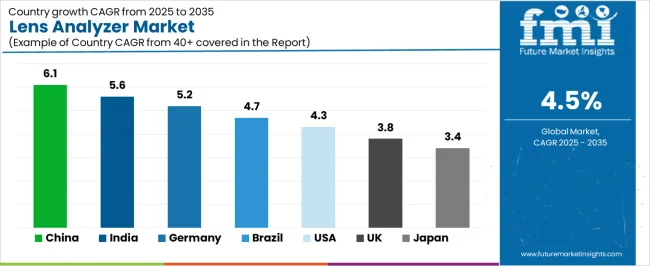
| Country | CAGR (2025-2035) |
|---|---|
| China | 6.1% |
| India | 5.6% |
| Germany | 5.2% |
| Brazil | 4.7% |
| United States | 4.3% |
| United Kingdom | 3.8% |
| Japan | 3.4% |
Regional synthesis reveals Asia Pacific markets leading adoption through healthcare infrastructure expansion and optical retail development, while European countries maintain steady expansion supported by clinical technology advancement and medical equipment standardization requirements. North American markets show moderate growth driven by hospital equipment upgrades and optical practice modernization trends.
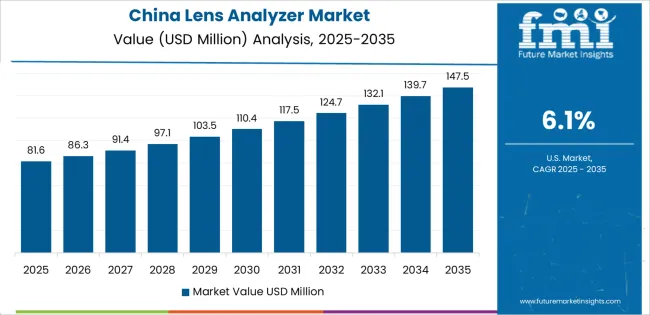
The Chinese market emphasizes advanced diagnostic features, including precision measurement control and integration with comprehensive hospital management platforms that manage clinical workflows, diagnostic optimization, and quality assurance applications through unified healthcare systems. The country demonstrates strong growth at 6.1% CAGR, driven by healthcare infrastructure expansion, optical retail growth initiatives, and emerging vision care service development that support analyzer integration. Chinese eye care providers prioritize operational effectiveness with lens analyzers delivering consistent diagnostic performance through advanced measurement capabilities and practice adaptation features.
Distribution channels include major hospital networks, optical retail chains, and healthcare equipment procurement programs that support professional applications for complex ophthalmology diagnostics and optical shop measurement applications. Practice management platform integration capabilities with established healthcare systems expand market appeal across diverse operational requirements seeking diagnostic accuracy and efficiency benefits. The expanding middle-class healthcare access and accelerating vision care awareness create continual demand, while innovative applications in telemedicine and digital health open new growth avenues.
Performance Metrics:
Advanced healthcare market in Germany demonstrates sophisticated analyzer deployment with documented operational effectiveness in hospital ophthalmology applications and optical retail facilities through integration with existing medical equipment systems and clinical infrastructure. The country leverages engineering expertise in precision measurement and diagnostic systems integration to maintain strong growth at 5.2% CAGR. Medical centers, including Frankfurt, Munich, and Hamburg, showcase premium installations where analyzer systems integrate with comprehensive hospital platforms and clinical management systems to optimize diagnostic quality and measurement effectiveness.
German equipment manufacturers prioritize system accuracy and medical compliance in analyzer development, creating demand for premium measurement systems with advanced features, including automation integration and quality verification systems. The market benefits from established healthcare infrastructure and willingness to invest in diagnostic technologies that provide long-term clinical benefits and compliance with medical equipment standards.
Market Intelligence Brief:
The USA lens analyzer market demonstrates sophisticated deployment across hospital ophthalmology applications with documented effectiveness in eye care clinics and optical retail facilities through integration with comprehensive practice management systems and healthcare infrastructure. The country leverages advanced technology capabilities in diagnostic innovation and clinical workflow optimization to maintain moderate growth at 4.3% CAGR. Medical centers, including major metropolitan areas, showcase premium installations where analyzer systems integrate with comprehensive healthcare platforms and optical retail networks to optimize diagnostic positioning and measurement effectiveness.
American eye care providers prioritize measurement accuracy and workflow efficiency in equipment selection, creating demand for innovative analyzer systems with advanced features, including electronic health record integration and automated measurement processing. The market benefits from established healthcare infrastructure and willingness to invest in diagnostic technologies that provide clinical quality enhancement and compliance with FDA and medical standards.
Market Intelligence Brief:
The UK lens analyzer market demonstrates advanced healthcare deployment with documented operational effectiveness in NHS hospitals and optical retail applications through integration with existing clinical systems and medical infrastructure. The country leverages regulatory expertise in medical equipment and healthcare systems integration to maintain steady growth at 3.8% CAGR. Medical centers, including London, Manchester, and Birmingham, showcase installations where analyzer systems integrate with comprehensive healthcare platforms and clinical management systems to optimize medical compliance and measurement effectiveness.
British healthcare providers prioritize system reliability and clinical compliance in equipment development, creating demand for certified analyzer systems with advanced features, including NHS integration and medical data management. The market benefits from established healthcare infrastructure and commitment to invest in diagnostic technologies that provide clinical benefits and compliance with UK medical equipment standards.
Strategic Market Indicators:
Lens analyzer market in India demonstrates rapid expansion with documented operational effectiveness in hospital ophthalmology applications and optical retail facilities through integration with emerging healthcare systems and vision care infrastructure. The country leverages growing healthcare capabilities in diagnostic equipment and medical systems integration to achieve high growth at 5.6% CAGR. Medical centers, including Mumbai, Delhi, and Bangalore, showcase expanding installations where analyzer systems integrate with comprehensive healthcare platforms and optical retail networks to optimize market penetration and measurement effectiveness.
Indian eye care providers prioritize diagnostic quality and service standards in equipment selection, creating demand for sophisticated analyzer systems with advanced features, including automated measurement integration and quality control systems. The market benefits from expanding healthcare infrastructure and willingness to invest in international-standard diagnostic technologies that provide clinical differentiation and compliance with medical quality standards.
Market Intelligence Brief:
Lens analyzer market in Brazil demonstrates expansion with documented operational effectiveness in hospital applications and optical retail facilities through integration with developing healthcare systems and vision care infrastructure. The country leverages growing healthcare capabilities in diagnostic equipment and medical integration to achieve growth at 4.7% CAGR. Medical centers, including São Paulo, Rio de Janeiro, and Brasília, showcase installations where analyzer systems integrate with healthcare platforms and optical networks to optimize market development and measurement effectiveness.
Brazilian eye care providers prioritize equipment value and clinical capability in analyzer selection, creating demand for cost-effective measurement systems with reliable features, including standard automation and healthcare compatibility. The market benefits from expanding healthcare infrastructure and investment in diagnostic equipment that provide clinical enhancement.
Market Intelligence Brief:
Lens analyzer market in Japan demonstrates precision deployment with documented operational effectiveness in premium hospital applications and specialty optical facilities through integration with advanced medical systems and quality control infrastructure. The country leverages engineering excellence in precision measurement and healthcare systems integration to maintain steady growth at 3.4% CAGR. Medical centers, including Tokyo, Osaka, and Yokohama, showcase installations where analyzer systems integrate with comprehensive clinical platforms and quality management systems to optimize diagnostic excellence and measurement effectiveness.
Japanese healthcare providers prioritize system precision and measurement excellence in equipment development, creating demand for premium analyzer systems with advanced features, including micro-precision measurement and diagnostic integration systems. The market benefits from established healthcare infrastructure and commitment to invest in highest-quality diagnostic technologies that provide superior clinical positioning and compliance with rigorous Japanese medical standards.
Strategic Market Indicators:
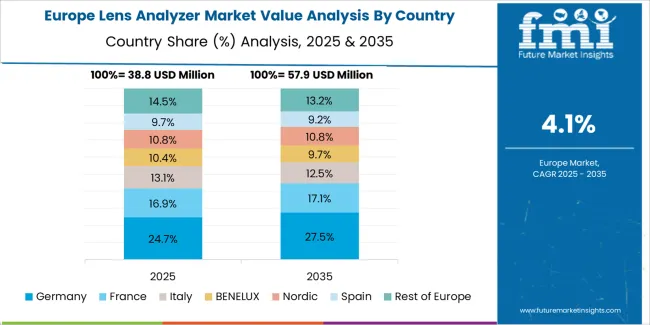
The lens analyzer market in Europe is projected to grow from USD 43.2 million in 2025 to USD 67.1 million by 2035, registering a CAGR of 4.5% over the forecast period. Germany is expected to maintain its leadership position with a 29.3% market share in 2025, projected to reach 30.1% by 2035, supported by its advanced healthcare infrastructure and major medical centers in Frankfurt and Munich. France follows with a 20.4% share in 2025, expected to reach 21.0% by 2035, driven by comprehensive hospital modernization programs and optical retail expansion.
The United Kingdom holds a 17.2% share in 2025, projected to reach 17.6% by 2035 through specialized NHS procurement activities and optical chain integration. Italy commands a 13.5% share, while Spain accounts for 10.8% in 2025. The Netherlands maintains a 4.3% share. The Rest of Europe region is anticipated to show steady adoption, with its collective share remaining at 4.5% through 2035, reflecting consistent growth in Nordic countries and emerging Central European healthcare markets implementing diagnostic equipment modernization programs.
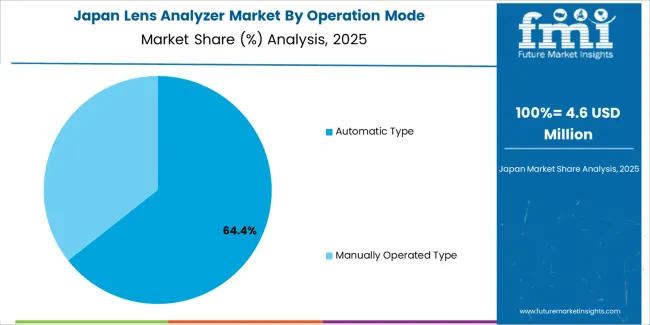
In Japan, the lens analyzer market prioritizes automatic type systems, which capture the dominant share of hospital ophthalmology and optical shop installations due to their advanced features, including precision measurement optimization and seamless integration with existing clinical infrastructure. Japanese eye care providers emphasize accuracy, efficiency, and long-term diagnostic excellence, creating demand for automatic type systems that provide consistent measurement capabilities and superior operational performance based on clinical requirements and quality standards. Manually operated systems maintain secondary positions primarily in small optical shops and budget-conscious practices where basic measurement functionality meets operational requirements without compromising service efficiency.
Market Characteristics:
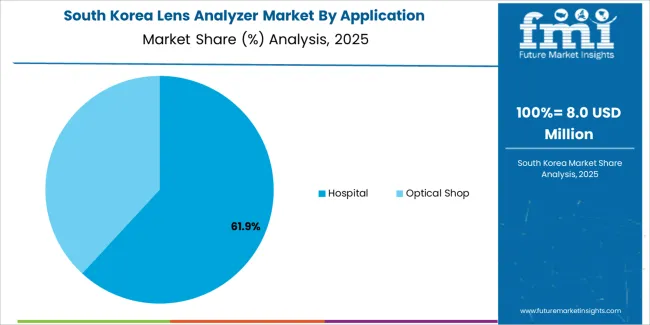
In South Korea, the market structure favors international ophthalmic equipment manufacturers, including Topcon Corporation, Luneau Technology, and Reichert, which maintain dominant positions through comprehensive product portfolios and established healthcare networks supporting both hospital ophthalmology and optical retail installations.
These providers offer integrated solutions combining advanced analyzer systems with professional service support and ongoing technical assistance that appeal to Korean eye care providers seeking reliable diagnostic measurement systems. Local medical equipment distributors capture moderate market share by providing localized service capabilities and competitive pricing for standard clinical applications, while domestic suppliers focus on specialized applications and cost-effective solutions tailored to Korean healthcare market characteristics.
Channel Insights:

The lens analyzer market operates with moderate concentration, featuring approximately 12-18 meaningful participants, where leading companies control roughly 48-53% of the global market share through established healthcare relationships and comprehensive diagnostic equipment portfolios. Competition emphasizes advanced measurement capabilities, automation technology, and clinical integration rather than price-based rivalry. The leading company, Topcon Corporation, commands approximately 22.0% market share through its extensive ophthalmic equipment product line and global healthcare industry presence.
Market Leaders encompass Topcon Corporation, Luneau Technology, and Reichert, which maintain competitive advantages through extensive optical measurement expertise, global healthcare networks, and comprehensive clinical integration capabilities that create customer loyalty and support premium pricing. These companies leverage decades of ophthalmic technology experience and ongoing innovation investments to develop advanced analyzer systems with precision diagnostic control and automation features. Technology Innovators include Zeiss, Huvitz, and regional specialists, which compete through specialized measurement technology focus and innovative diagnostic capabilities that appeal to practitioners seeking advanced optical solutions and clinical differentiation.
These companies differentiate through rapid technology development cycles and specialized hospital application focus. Regional Specialists feature equipment manufacturers focusing on specific geographic markets and specialized applications, including portable analyzer systems and integrated practice solutions. Market dynamics favor participants that combine reliable measurement accuracy with advanced automation capabilities, including precision diagnostic control and workflow optimization features. Competitive pressure intensifies as traditional ophthalmic equipment suppliers expand into automated analyzer systems, while specialized optical technology companies challenge established players through innovative measurement solutions and connectivity platforms targeting premium hospital and optical retail segments.
| Item | Value |
|---|---|
| Quantitative Units | USD 167.4 million |
| Operation Mode | Manually Operated Type, Automatic Type |
| Application | Hospital, Optical Shop |
| Regions Covered | Asia Pacific, Europe, North America, Latin America, Middle East & Africa |
| Countries Covered | China, India, Germany, Brazil, United States, United Kingdom, Japan, and 20+ additional countries |
| Key Companies Profiled | Topcon Corporation, Luneau Technology, Reichert, Zeiss, Huvitz, Essilor, Righton, Rexxam, Nidek, Marco, Takagi Seiko, Ningbo FLO Optical Technology |
| Additional Attributes | Dollar sales by operation mode and application categories, regional adoption trends across Asia Pacific, Europe, and North America, competitive landscape with ophthalmic equipment manufacturers and optical technology suppliers, practitioner preferences for automation and diagnostic accuracy, integration with healthcare platforms and practice management systems, innovations in measurement technologies and connectivity capabilities, and development of automated diagnostic solutions with enhanced performance and clinical optimization capabilities. |
The global lens analyzer market is estimated to be valued at USD 167.4 million in 2025.
The market size for the lens analyzer market is projected to reach USD 260.0 million by 2035.
The lens analyzer market is expected to grow at a 4.5% CAGR between 2025 and 2035.
The key product types in lens analyzer market are automatic type and manually operated type.
In terms of application, hospital segment to command 59.6% share in the lens analyzer market in 2025.






Full Research Suite comprises of:
Market outlook & trends analysis
Interviews & case studies
Strategic recommendations
Vendor profiles & capabilities analysis
5-year forecasts
8 regions and 60+ country-level data splits
Market segment data splits
12 months of continuous data updates
DELIVERED AS:
PDF EXCEL ONLINE
Camera Lens Market Size and Share Forecast Outlook 2025 to 2035
Contact-lens Induced Infections Market Size and Share Forecast Outlook 2025 to 2035
Contact Lens Inspection Equipment Market Size and Share Forecast Outlook 2025 to 2035
Optical Lens Materials Market Size and Share Forecast Outlook 2025 to 2035
Contact Lens Industry Analysis in GCC Size and Share Forecast Outlook 2025 to 2035
Scleral Lenses Market Size and Share Forecast Outlook 2025 to 2035
Contact Lenses Market – Trends, Growth & Forecast 2025 to 2035
Contact Lens Solution Market Analysis by Product Type, Volume, Purpose, Distribution Channel, and Region through 2035
Acrylic Lenses Market
Anti-Fog Lens Market Insights - Size, Trends & Forecast 2025 to 2035
Global Spectacle Lens Market Analysis – Size, Share & Forecast 2024-2034
Aspherical Lens Market Size and Share Forecast Outlook 2025 to 2035
Intraocular Lens Market Size and Share Forecast Outlook 2025 to 2035
Collimating Lens Market – Growth & Technology Trends 2025 to 2035
IR Corrected Lenses Market Size and Share Forecast Outlook 2025 to 2035
Key Companies & Market Share in the Prescription Lens Industry
Smart Contact Lens Market Size and Share Forecast Outlook 2025 to 2035
Digital Vision Lenses Market
Hydrogel Contact Lenses Market
Optical Telephoto Lens Market Size and Share Forecast Outlook 2025 to 2035

Thank you!
You will receive an email from our Business Development Manager. Please be sure to check your SPAM/JUNK folder too.
Chat With
MaRIA